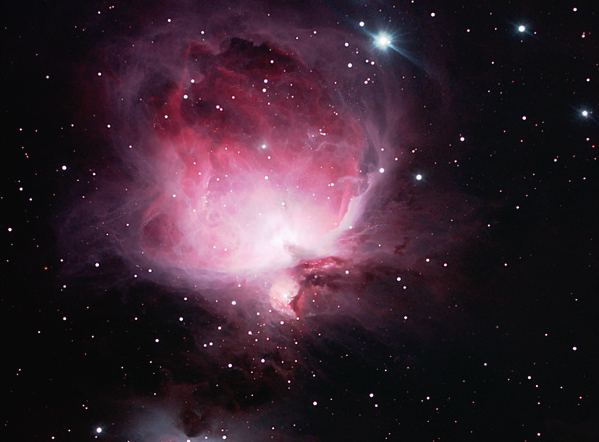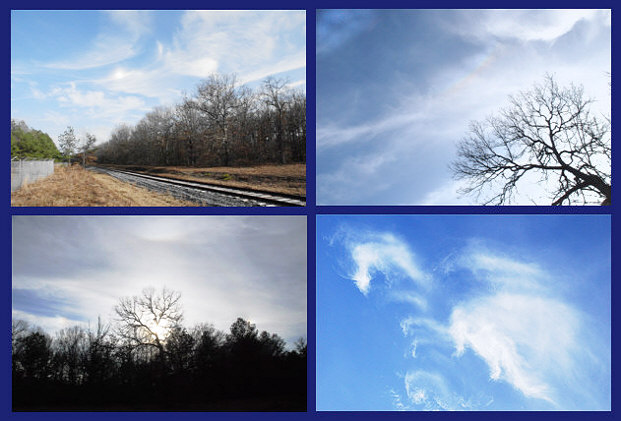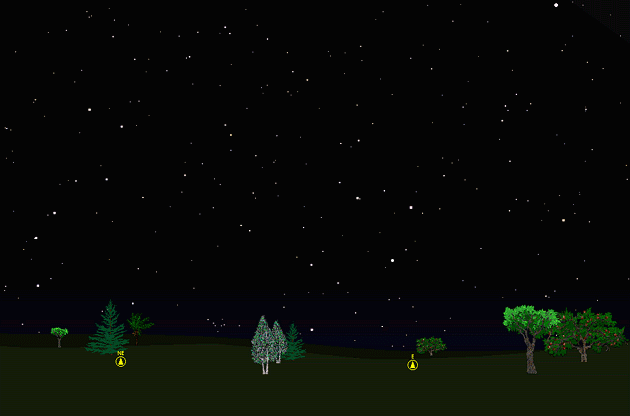The purpose of this feature is to give scout leaders, educators and naturalists an idea of some of the natural events coming up each month. We will try to cover a variety of natural events ranging from sky events to calling periods of amphibians, bird and mammal watching tips, prominent wildflowers and anything else that comes to mind. We will also note prominent constellations appearing over the eastern horizon at mid-evening each month for our area for those who would like to learn the constellations. If you have suggestions for other types of natural information you would like to see added to this calendar, let us know! Note: You can click on the hyperlinks to learn more about some of the featured items. To return to the Calendar, hit the "back" button on your browser, NOT the "back" button on the web page. All charts are available in a "printer friendly" mode, with black stars on a white background. Left clicking on each chart will take you to a printable black and white image.
Notes and Images From December 2007
Clouds, both near and far, have been on my mind a lot lately. The Orion Nebula is the brightest part of a vast interstellar cloud complex that covers the entire constellation of Orion. I took this image on December 30th. Stars in the bright center of the nebula bathe the surrounding clouds of gas with intense radiation, causing the nebula to glow. The rose hue of the nebula in the image is due to hydrogen and can be seen visually only in large telescopes. The Orion Nebula is about 1270 light-years distant. The brighter part of the nebula as shown is about 24 light-years in diameter. To get a sense of the scale of this majestic cloud, consider that an image of the earth on the same scale would appear much smaller than the diameter of one hydrogen atom.
The clouds that captured my imagination on December 13th were quite a bit closer to home. It had been a cold, windy day under an unrelenting gray overcast. I soldiered on, but it was not a very inspiring day. Late in the afternoon the clouds started to break up, and the overcast was swept away to reveal a layer of wispy cirrus clouds against a blue sky. A bright spot in the clouds appeared at the same altitude as the sun. I recognized it as a parhelion, or sundog, but unlike most parhelia, it was not 22 degrees from the sun. It was a full 120 degrees in azimuth from the sun’s position. These 120 degree parhelia are rare – this is the first one I've seen. I have learned that if you see one type of halo phenomena, look for more. Every few minutes I checked the sky directly overhead. Sure enough, about 30 minutes later, I saw a circumzenithal arc take form. These beautiful arcs form around a point (the zenith) directly over the observer’s head, and are caused by sunlight refracted through ice crystals. Fainter than rainbows, and more ethereal, they shimmer as the wispy crystal-laden cirrus clouds pass overhead. Normally, only about a third of a full circle is visible. You will see more of these arcs if you get in the habit of looking up at intervals when the sky is filled with cirrus clouds, particularly when the sun is 20 degrees or closer to the horizon. The cirrus clouds continued to drift by, changing form in the wind. Against the deep blue sky, a winged dragon appeared, smoke coming from its nostrils. It turned a slow cartwheel and disappeared. A faint 22 degree halo formed around the sun, with normal parhelia on each side of the halo. Upper tangential arcs sat atop the 22 degree halo like a crown. It is the nature of clouds to bring change, and I found that the drifting cirrus clouds had brought about a change in my own mindset that day.
Sky Events for January 2008: Earth is at perihelion, closest to the sun, on January 2nd. If these late sunrises are depressing you, take heart. The latest sunrise for this winter occurs on January 7th. The latest sunrise occurs around 2 weeks after the shortest day because of the effect of the earth's tilt to the plane of its orbit. The Quadrantid Meteor Shower peaks in the early morning hours of January 4th. The meteors will appear to radiate from the northern part of the constellation Bootes. The name of the shower comes from an obsolete constellation, Quandrans Muralis, found in early 19th century star atlases between Draco, Hercules and Bootes. Evening Sky: Mars is now starting to fade as the earth pulls away from it. Look for the red planet low in the ENE after in the evening twilight. It remains visible all night long. Saturn rises around 8:15pm CST at mid-month. If you wait until it has climbed high in sky, you will be treated to a stunning view in just about any telescope. Look for Mercury low in the western sky after sunset around the end of the 2nd week of January. Start your search about 30 minutes after sunset. Morning Sky: Venus rises around 4:30am CST at mid-month. As the month progresses, watch for Jupiter to appear below Venus and to gradually approach to within 1.2 degrees by the end of the month. All times noted in the Sky Events are for Franklin, Tennessee and are Central Standard Time. These times should be pretty close anywhere in the mid-state area. Constellations: The views below show the sky looking east at 9:30pm CST on January 15th. The first view shows the sky with the constellation outlines and names depicted. Star and planet names are in yellow. Constellation names are in green. The second view shows the same scene without labels. The too-long tail of Ursa Major, the Great Bear, has now cleared the horizon and Hydra, the Water Serpent, rears its head menacingly. Its brightest star Alphard is known as "The Solitary One" because of its somewhat isolated location from other bright stars. Canes Venatici, the Hunting Dogs, also make their appearance. Among the fainter constellations visible in the east are Leo Minor, the Small Lion, Cancer, the Crab, and Sextans, the Sextant.
On Learning the Constellations: We advise learning a few constellations each month, and then following them through the seasons. Once you associate a particular constellation coming over the eastern horizon at a certain time of year, you may start thinking about it like an old friend, looking forward to its arrival each season. The stars in the evening scene above, for instance, will always be in the same place relative to the horizon at the same time and date each January. Of course, the planets do move slowly through the constellations, but with practice you will learn to identify them from their appearance. In particular, learn the brightest stars (like Regulus and Procyon in the scene looking east), for they will guide you to the fainter stars. Once you can locate the more prominent constellations, you can "branch out" to other constellations around them. It may take you a little while to get a sense of scale, to translate what you see on the computer screen or what you see on the page of a book to what you see in the sky. Look for patterns, like the stars of the "Big Dipper." The earth's rotation causes the constellations to appear to move across the sky just as the sun and the moon appear to do. If you go outside earlier than the time shown on the charts, the constellations will be lower to the eastern horizon. If you observe later, they will have climbed higher. As each season progresses, the earth's motion around the sun causes the constellations to appear a little farther towards the west each night for any given time of night. If you want to see where the constellations in the above figures will be on February 15th at 9:00pm CST, you can stay up till 11:00pm CST on the January 15th and get a preview. The westward motion of the constellations is equivalent to two hours per month. For instance, if you want to see what stars will be on your eastern horizon on April 15th at 9:00pm CST (3 months later), you would need to get up at 3:00am CST in the morning on January 15th (3 months times 2 hours/month = 6 hours).
Sky Publishing has just come out with a beautiful and compact star atlas, Sky & Telescope's Pocket Star Atlas. It is destined to become a classic, and is a joy to use at the telescope. A good book to learn the constellations is H. A. Rey's
classic,
The Stars, A New Way to See Them. Rey's depictions of the
constellations and witty commentary are terrific. A good general reference book on astronomy is the Peterson
Field Guide,
A Field Guide to the Stars and Planets, by Pasachoff.
The book retails for around $14.00. A good beginners software program for learning the night sky
is the Starry Night Beginner program. Visit the Starry Night web site at
www.starrynight.com The program retails for around $30.00 and
contains a wealth of information.
Amphibians:
A lot of things happen with amphibians in January. To see them, though, you have to be out in the sort of weather that makes most people stay indoors. The trick is to go out on mild (50 degrees Fahrenheit or warmer) rainy nights. For safety, it is important that you have another person with you to watch for traffic as you slowly drive the back roads, looking for things that cross the road in front of you and frequently stopping and listening. Southeastern Chorus Frogs, who can have breeding choruses as early as December, are calling more frequently now. In January, calling Spring Peepers become more common (they have been observed calling every month in Tennessee). Wood Frogs have their short-lived breeding choruses in woodland ponds, where they are often joined by Spotted Salamanders. Tiger Salamanders also breed in January in less wooded areas and the eggs of both can often be found this time of year. For photos of common winter egg masses, click here. Southern Leopard Frogs are also sometimes calling on mild January nights. We have seen Northern Cricket Frogs, Green Frogs, American Bullfrogs and American Toads foraging in January. And just about anything is possible. On January 22, 1999, we found a Eastern Spadefoot out in the stormy weather. That same day a tornado ripped through Clarksville, Tennessee, doing much damage to the Austin Peay campus. January is an exciting time of year to look for herps!
Birds: If you walk grassy fields that have some wetter areas, you may flush a Short-Eared Owl, a winter resident in Tennessee. We have flushed them from fields at Pardue’s Pond near Ashland City, along the roads that go to Pace Point near Big Sandy, Tennessee, at Britton Ford near Dover, Tennessee and at Savannah Bottoms, south of Savannah, Tennessee. These birds tend to occupy the same habitat as Northern Harriers, so if you see Harriers over grassy fields, be on the lookout for the owls. They often begin flying in the late afternoon, coursing over the fields like a Harrier. It’s a good idea to check any “Northern Harrier” you see in the late afternoon to make sure it’s not a Short-eared Owl. Now is also the time to walk pine and cedar thickets to look for rare owls like Long-eared Owls and Northern Saw-whet Owls. Both species have been seen in the Nashville area this year. This is also the perfect time of year to scan for stick nests as you drive along state highways and interstates (preferably with someone else doing the driving!) They are much easier to spot now that the leaves have fallen. You can map out the location of the nests you discover, and then check them to see if they are occupied later in the season. I have found several Great Horned Owl's nests in this way. If you do find an occupied nest, please respect the birds and do not try to approach the nest. Doing so will stress the birds and may cause them to abandon the nest. If you find a young bird on the ground, leave it where it is. The parents will continue to care for it on the ground. Sometimes well meaning people "rescue" such birds and many times the end result is a bird condemned to living its life in a cage. You probably have already put out your bird feeders, but if you haven’t you're missing out on a lot of good looks at winter feeder birds. This is a great time of year to start learning your birds. Watch and listen for winter residents such as White-throated and White-crowned Sparrows, Yellow-bellied Sapsuckers, Red-breasted Nuthatches, Golden-crowned Kinglets and Brown Creepers. Recommended: Bird Finding in Tennessee, Michael Lee Bierly. A classic guide to finding birds in Tennessee. The Sibley Guide to Birds, David Allen Sibley The Sibley Guide to Birds of Eastern North America, David Allen Sibley This new Sibley Guide covers only eastern North America, is quite compact, and is less expensive than the larger Sibley. An inexpensive guide for beginners is the Golden Guide for Birds.
Archives (Remember to use the back button on your browser, NOT the back button on the web page!) Natural Calendar December 2007 Natural Calendar November 2007 Natural Calendar September 2007 Natural Calendar February 2007 Natural Calendar December 2006 Natural Calendar November 2006 Natural Calendar September 2006 Natural Calendar February 2006
Natural Calendar December 2005
Natural Calendar November 2005
Natural Calendar September 2005
Natural Calendar February 2005
Natural Calendar December 2004
Natural Calendar November 2004
Natural Calendar September 2004
Natural Calendar February 2004
Natural Calendar December 2003
Natural Calendar November 2003
Natural Calendar September 2003 Natural Calendar February 2003 Natural Calendar December 2002 Natural Calendar November 2002 Nature Notes Archives: Nature Notes was a page we published in 2001 and 2002 containing our observations about everything from the northern lights display of November 2001 to frog and salamander egg masses. Night scenes prepared with Starry Night Pro software All images and recordings © 2008 Leaps
|




